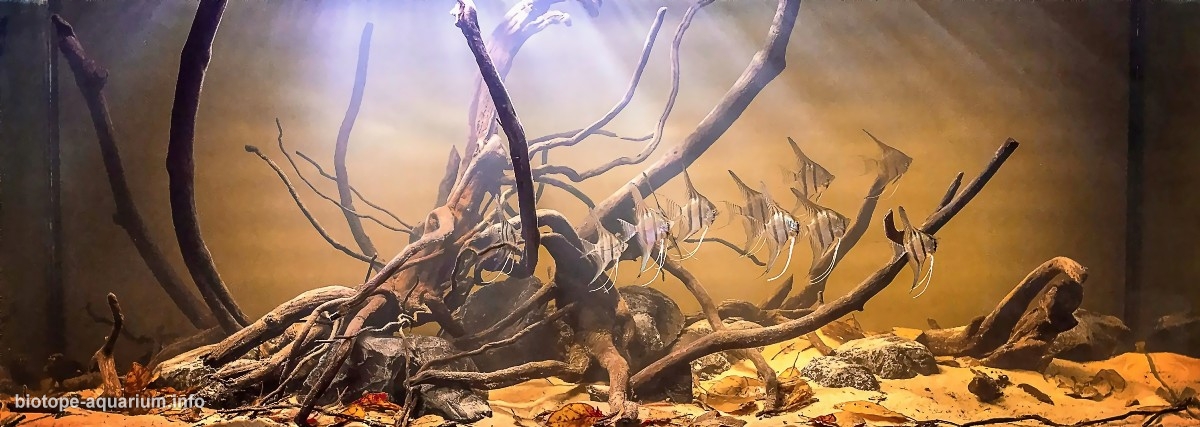Flooded Essequibo River Coast in Iwokrama Nature Reserve, Guyana
33th place in Biotope Aquarium Design Contest 2019
Ukraine. Bogdan Oleynik

Volume: 480 L
Dimensions: 160x50x60 cm
List of fishes: Pterophyllum scalare
List of plants: –
Description of decorations: In the aquarium, I used river sand which, by type and color, corresponds to the sand of the Essekibo River (VIDEO 39.22 min). Rock piles of rock color and texture repeat the rocks of the Acarai mountains, which are widespread throughout most of the river (PHOTO 1, VIDEO 41.20min). In an attempt to repeat the natural environment of the underwater landscape in the aquarium, driftwood of apple, oak and grapes are used, imitating flooded trees during the flood. The deciduous cover resembling the fallen leaves of the flooded trees of this area in the aquarium is made of oak leaves, previously manually cut, in order to give them the natural shape of the corresponding species of the local flora such as Carapa guianensis Aubl. The light brown shade of water inherent in this reservoir (VIDEO 36.17 min) I gave with the help of 15 l of water poured into the aquarium in which the driftwood of oak was repeatedly boiled to the desired shade. The effect of turbid water, which is formed during floods, was created using washed, pre-cleaned quarry sand of a very fine fraction.
Description of equipment: External filter Hagen Fluval FX6, SAMP 96 l (volcanic lava – 10 l, JBL MicroMec 650 – 3 l, JBL Cermec – 3 l), LED lamps E27, 30 watts, 6500K, 3300 L, E27, 20 watts 3000K, 1900 L. 2 lamps of 30 watts each T8 4000K (for the background). Heater 300 watts, compressor.
Water parameters: Temperature is 26°C; KH 7; GH 9; PH 6.5.
Additional info: Water changes once a week in the amount of 50% of the total volume of the aquarium. External filter maintenance twice a year. Washing filter socks in SAMP once a month.
INFORMATION ABOUT BIOTOPE
Description of the area surrounding the biotope: The Iwokrama Nature Reserve of nearly 3,710 square kilometers (1,430 square miles) of central Guyana, located in the heart of the Guiana Shield, is one of the last four untouched tropical forests in the world. It represents an important transitional zone in the areas of precipitation, terrain, human history and biological communities. The ecosystem of the Iwokrama forest is located at the junction of the Amazonian and Guiana flora and fauna. The area is covered by low-lying rainforest, where tall tropical trees dominate with a dense canopy ranging in height from 20 to 30 meters (70-100 feet). The Essequibo River passes through the reserve mainly along the flat terrain with a slow flow. Despite this, on its way there are slight elevations of the landscape during which you can see stone boulders that form piles rising above the water, steep rapids, waterfalls.
Description of the underwater landscape of the biotope: For my work, the landscape of the flooded coast was selected during the floods on the Essequibo River, the territory of Iwokrama Nature Reserve, Gayana. In one of the photos (PHOTO 1) that I used for my work, you can see a slowly flowing river among the shores of light yellow sand surrounded by dense forests. Between the rainy season, when the water level drops significantly, from time to time exposing lonely stone piles on the coast surface. Some of them have good conditions for the germination of plants and trees between them, as shown in the photo. In a fairly short time, they can turn a gray island consisting of stone boulders and yellowish sand into a green hat rising above the water, as shown in the photo (PHOTO 2). Such islands can often be found along the entire coast of the reserve, creating spectacular views of untouched nature. There is a large number of extinct or endangered species in their former geographical areas. The subequatorial climate is hot and humid in the country. Two rainy seasons from April to August and from November to January, bring floods, causing the Essequibo River to flood significantly increasing its water level. During floods, the upper reaches of the Branco River (part of the Amazon basin) and the Essequibo River are interconnected, providing a level of exchange of aquatic fauna, such as fish, between the two systems. At that time, such stone coasts overgrown with vegetation, small bushes and trees of the type Carapa guianensis Aubl significantly or completely submerged in water, leaving only tree crowns and gray rocky rocks on the surface (PHOTO 3). The arrival of new masses of water also begins to change the underwater landscape, forcing some species of fish to seek a new habitat. I showed this moment in my aquarium, displaying the surface of one of such submerged stone piles off the coast. Caught in the power of the water element. Far from the turbulent currents with calm water, among the roots and branches of trees, securely fixed among stone boulders, they found a haven of Pterophyllum scalare. In the murky light brown water under the playing rays of the rising sun and stretching from the bottom to the surface of the water trunks of sunken trees, they meet their new day.
Description of the parameters of the habitat: River water has a light brown hue. Depending on the season, it may be more cloudy or transparent. Water parameters in a natural biotope: pH 5.0-6.5, hardness 0.5-1, KN 0. Average temperature 21-23C.
List of fishes and invertebrates occurring in the nature biotope: Arapaima gigas, Pygocentrus nattereri, Hemigrammus erythrozonus, Carnegiella strigata, Corydoras aeneus, Heros severus, Metynnis argenteus, Hoplosternum thoracatum.
List of plants found in the nature biotope: Echinodorus grisebachii, Echinodorus bolivianus, Cabomba furcata, Eleocharis acicularis.
Threats to the ecology: –
Sources of information:
PHOTO 1
https://www.gettyimages.co.uk/
PHOTO 2
https://www.alamy.com/aerial-
PHOTO 3
https://www.tripadvisor.com/
VIDEO 4
https://rutube.ru/video/
https://www.fishbase.se/
https://wikivisually.com/wiki/
https://hasta-pronto.ru/reki/
https://paddlingmag.com/
https://en.m.wikipedia.org/
